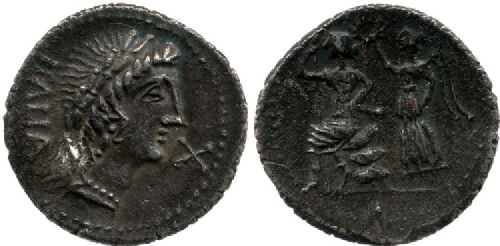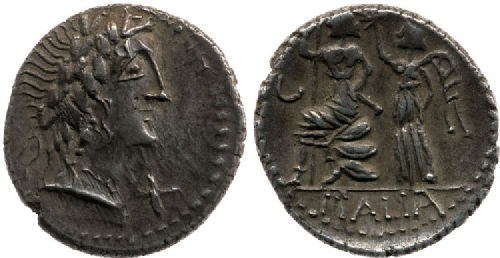All entries for Friday 13 February 2015
February 13, 2015
The Social Life of Images in the Social War
In the period 90-88 BC several Italian allies revolted from Roman control, objecting that they contributed resources and troops to the Roman cause while receiving little in return. The assassination of Marcus Livius Drusus, who proposed granting Italian allies Roman citizenship, in 91 BC sparked revolt. The Italians created their own confederation named Italia, with a new capital at Corfinium, which was renamed Italica (see Diodorus Siculus 37.4).
 |
|
Roman Republican Denarius showing Apollo and Roma
(RRC 335/1). © The Trustees of the British Museum
|
The Italians also began to strike their own coinage, which carried a mixture of Roman and non-Roman elements. The coins were denarii, and circulated alongside Roman issues (at least, we find them buried alongside Roman denarii in hoards). Alongside Latin, Oscan was used. Some types derived from Roman coinage; one in particular demonstrates how imagery can shift and change meaning according to context, an idea explored in several other posts on this blog. In c. 96 BC the moneyers at Rome released a type showing the wreathed head of Apollo on the obverse and Roma seated on a pile of shields on the reverse, holding a sword and shield and being crowned by Victory (RRC 335/1-2).
This imagery was then adopted by the Italians during the Social War, but the head of Apollo and the figure of Roma were given a very different meaning. On one type (HN Italy 412a) the laureate head is given a necklace and accompanied by the legend ITALIA: the head has now become the personification of Italia herself. On the other issue (HN Italy 412b), the legend ITALIA is found on the reverse, suggesting that the image of Roma being crowned by Victory has transformed into a triumphant image of Italia.
 |
 |
|
Denarius of the Italians from the Social War (HN Italy 412a). © The Trustees of the British Museum.
|
Denarius of the Italians from the Social War (HN Italy 412b). © The Trustees of the British Museum.
|
Thus during their rebellion from Roman control the Italians took existing imagery and converted it to support their cause, communciating these new meanings through the clever use and placement of legends. That the Italians felt the need to strike their own coinage demonstrates the role of money in the formulation and expression of identity. These coins and others struck by the Italians represent one of the few pieces of evidence that suggest dissatisfaction with Roman Republican control. The Romans did not take too kindly to this material manifestation of opposition: at the end of the war, it is clear that the coinage of the Italian allies was melted down and converted into Roman denarii. What is left to us today are those coins which were lost before the conclusion of the war, or those which somehow were overlooked during this process.
 Clare Rowan
Clare Rowan

 Please wait - comments are loading
Please wait - comments are loading

 Loading…
Loading…